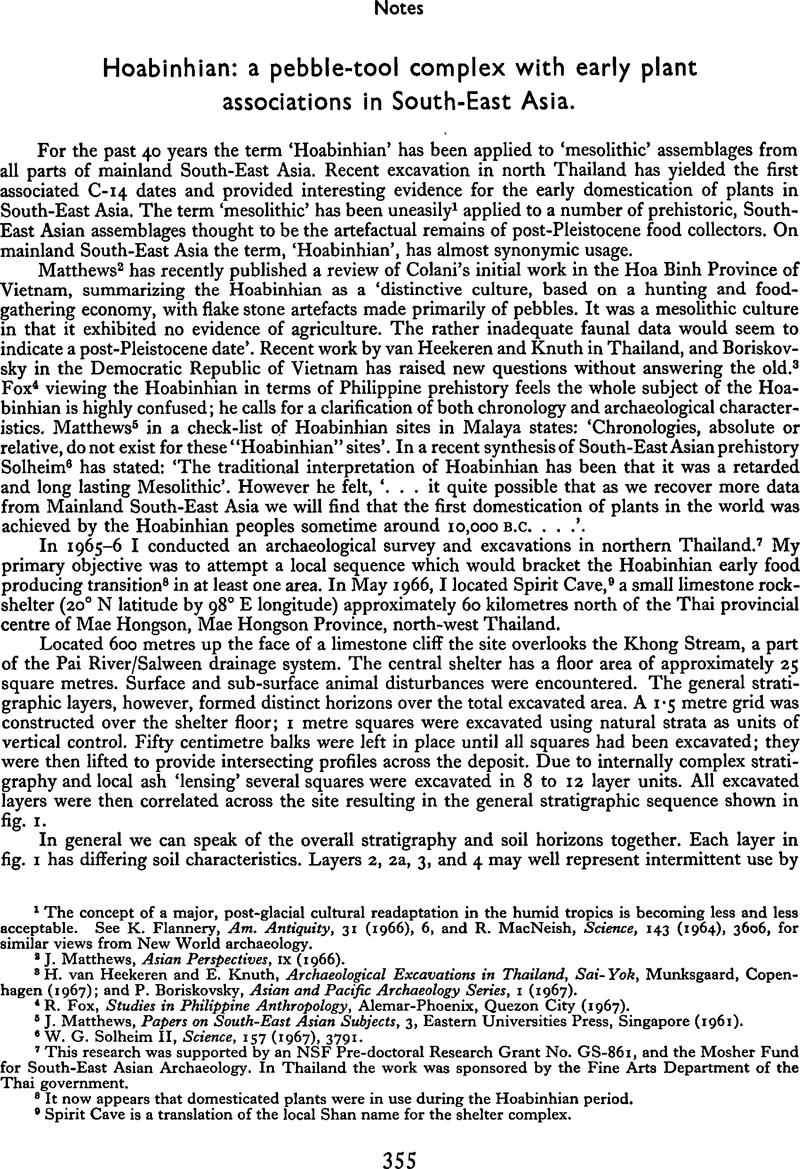Article contents
Hoabinhian: a pebble-tool complex with early plant associations in South-East Asia
Published online by Cambridge University Press: 27 May 2014
Abstract

- Type
- Notes
- Information
- Copyright
- Copyright © The Prehistoric Society 1970
References
page 355 note 1 The concept of a major, post-glacial cultural readaptation in the humid tropics is becoming less and less acceptable. See Flannery, K., Am. Antiquity, 31 (1966), 6CrossRefGoogle Scholar, and MacNeish, R., Science, 143 (1964), 3606CrossRefGoogle Scholar, for similar views from New World archaeology.
page 355 note 2 Matthews, J., Asian Perspectives, IX (1966)Google Scholar.
page 355 note 3 van Heekeren, H. and Knuth, E., Archaeological Excavations in Thailand, Sat- Yok, Munksgaard, Copenhagen (1967)Google Scholar; and Boriskovsky, P., Asian and Pacific Archaeology Series, I (1967)Google Scholar.
page 355 note 4 Fox, R., Studies in Philippine Anthropology, Alemar-Phoenix, Quezon City (1967)Google Scholar.
page 355 note 5 Matthews, J., Papers on South-East Asian Subjects, 3, Eastern Universities Press, Singapore (1961)Google Scholar.
page 355 note 6 Solheim, W. G. II, Science, 157 (1967), 3791CrossRefGoogle Scholar.
page 355 note 7 This research was supported by an NSF Pre-doctoral Research Grant No. GS-861, and the Mosher Fund for South-East Asian Archaeology. In Thailand the work was sponsored by the Fine Arts Department of the Thai government.
page 355 note 8 It now appears that domesticated plants were in use during the Hoabinhian period.
page 355 note 9 Spirit Cave is a translation of the local Shan name for the shelter complex.
page 357 note 1 Matthews, J., The Hoabinhian in South-East Asia and elsewhere. Unpublished dissertation, Australian National University, Canberra (1964)Google Scholar.
page 357 note 2 MacDonald, G. F. and Sanger, D., Am. Antiquity, 33 (1968), 2CrossRefGoogle Scholar.
page 357 note 3 See P. Boriskovsky, op. cit.
page 357 note 4 In preparation.
page 357 note 5 Botanical materials, mostly carbonized, were identified by Douglas Yen, Ethnobotanist and Peter van Royen, Botanist at the Bishop Museum, Honolulu. The tree genera were identified from fragmentary remains of seed pericarp. Cucumis was represented by one seed, and Lagenaria by a number of fragments of fruit exocarp. The bean identifications were made on two whole carbonized seeds. The individual structure which first suggested a seed of Pisum might equally be representative of a form of Palmae. Although common names have been used to describe the remains, the tentative nature of the identifications and the allowance for genetic changes in species in time have obviated the use of equivalent Linnean binomials.
page 357 note 6 Burkhill, I. H., Economic Products of the Malay Peninsula, London (1935)Google Scholar.
page 358 note 1 Chang, K. C. and Stuiver, M., Proc. Nat. Acad. Aci. U.S., 55 (1966), 3Google Scholar; Chang, K. C., Asian Perspectives, IX (1966)Google Scholar.
page 358 note 2 See Solheim, op. cit., also The Bangkok Post Sunday Magazine, vol. XXII, no. 229 (Aug. 18, 1968)Google Scholar for a report of D. T. Bayard's discovery of early (c. 3000 B.C.) copper from north-east Thailand.
page 358 note 3 Benedict, P. K., Behavioral Science Notes, vol. 2, nos. 3–4 (1967)Google Scholar.
- 4
- Cited by


